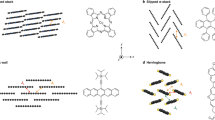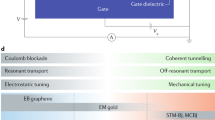Abstract
The study of charge transport through increasingly complex small molecules will benefit from a detailed understanding of how contaminants from the environment affect molecular conduction. This should provide a clearer picture of the electronic characteristics of molecules by eliminating interference from adsorbed species. Here we use magnetically assembled microsphere junctions incorporating thiol monolayers to provide insight into changing electron transport characteristics resulting from exposure to air. Using this technique, current–voltage analysis and inelastic electron tunnelling spectroscopy (IETS) demonstrate that the primary interaction affecting molecular conduction is rapid hydration at the gold–sulphur contacts. We use IETS to present evidence for changing mechanisms of charge transport as a result of this interaction. The detrimental effects on molecular conduction discussed here are important for understanding electron transport through gold–thiol molecular junctions once exposed to atmospheric conditions.
This is a preview of subscription content, access via your institution
Access options
Subscribe to this journal
Receive 12 print issues and online access
$259.00 per year
only $21.58 per issue
Buy this article
- Purchase on Springer Link
- Instant access to full article PDF
Prices may be subject to local taxes which are calculated during checkout





Similar content being viewed by others
References
Tour, J. M. Molecular Electronics: Commercial Insights, Chemistry, Devices, Architectures and Programming (World Scientific, River Edge, New Jersey, 2003).
Carroll, R. L. & Gorman, C. B. The genesis of molecular electronics. Angew. Chem. Int. Edn 41, 4378–4400 (2002).
Joachim, C. & Ratner, M. A. Molecular electronics: Some views on transport junctions and beyond. Proc. Natl Acad. Sci. 102, 8801–8808 (2005).
Rakshit, T., Liang, G. C., Ghosh, A. W. & Datta, S. Silicon-based molecular electronics. Nano Lett. 4, 1803–1807 (2004).
Seminario, J. M., Córdova, L. E. & Derosa, P. A. An ab initio approach to the calculation of current-voltage characteristics of programmable molecular devices. Proc. IEEE 91, 1958–1975 (2003).
Seminario, J. M. & Yan, L. Ab initio analysis of electron currents in thioalkanes. Int. J. Quantum Chem. 102, 711–723 (2005).
Seminario, J. M., Cruz, C. D. L., Derosa, P. A. & Yan, L. Nanometer-size conducting and insulating molecular devices. J. Phys. Chem. B 108, 17879–17885 (2004).
Salomon, A. et al. Comparison of electronic transport measurements on organic molecules. Adv. Mater. 15, 1881–1890 (2003).
Selzer, Y. et al. Effect of local environment on molecular conduction: Isolated molecule versus self-assembled monolayer. Nano Lett. 5, 61–65 (2005).
Wang, W., Lee, T. & Reed, M. A. Electronic transport in molecular self-assembled monolayer devices. Proc. IEEE 93, 1815–1824 (2005).
Moore, A. M. et al. Molecular engineering and measurements to test hypothesized mechanisms in single molecule conductance switching. J. Am. Chem. Soc. 128, 1959–1967 (2006).
Selzer, Y., Salomom, A. & Cahen, D. The importance of chemical bonding to the contact for tunneling through alkyl chains. J. Phys. Chem. B 106, 10432–10439 (2002).
Basch, H., Cohen, R. & Ratner, M. A. Interface geometry and molecular junction conductance: Geometric fluctuation and stochastic switching. Nano Lett. 5, 1668–1675 (2005).
Chechik, V., Crooks, R. M. & Stirling, C. J. M. Reactions and reactivity in self-assembled monolayers. Adv. Mater. 12, 1161–1171 (2000).
Ulman, A. Formation and structure of self-assembled monolayers. Chem. Rev. 96, 1533–1554 (1996).
Karpovich, D. S. & Blanchard, G. J. Vapor adsorption onto metal and modified interfaces: Evidence for adsorbate penetration of an alkanethiol monolayer on gold. Langmuir 13, 4031–4037 (1997).
Anderson, M. R., Evaniak, M. N. & Zhang, M. Influence of solvent on the interfacial structure of self-assembled alkanethiol monolayers. Langmuir 12, 2327–2331 (1996).
Pi, U. H. et al. Current flow through different phases of dodecanethiol self-assembled monolayer. Surf. Sci. 583, 88–93 (2005).
Long, D. P. et al. Magnetic directed assembly of molecular junctions. Appl. Phys. Lett. 86, 153105–153107 (2005).
Blum, A. S. et al. Molecularly inherent voltage-controlled conductance switching. Nature Mater. 4, 167–172 (2004).
Kushmerick, J. G., Blum, A. S. & Long, D. P. Metrology for molecular electronics. Anal. Chim. Acta 568, 20–27 (2006).
Poirier, G. E., Pylant, E. D. & White, J. M. Crystalline structures of pristine and hydrated mercaptohexanol self-assembled monolayers on Au(111). J. Chem. Phys. 104, 7325–7328 (1996).
Rablen, P. R., Lockman, J. W. & Jorgensen, W. L. Ab initio study of hydrogen-bonded complexes of small organic molecules with water. J. Phys. Chem. A 102, 3782–3797 (1998).
Steinwender, E. & Mikenda, W. Hydrogen bonding in 2-hydroxybenzoyl and 2-hydroxythiolbenzoyl compounds: Spectroscopic characterization and spectroscopic bond strength sequences. Monatsh. Chem. 125, 695–705 (1994).
Cai, L. et al. Reversible bistable switching in nanoscale thiol-substituted oligoaniline molecular junctions. Nano Lett. 5, 2365–2372 (2005).
Kushmerick, J. G. et al. Vibronic contributions to charge transport across molecular junctions. Nano Lett. 4, 639–642 (2004).
Wang, W., Lee, T., Kretzschmar, I. & Reed, M. A. Inelastic electron tunneling spectroscopy of an alkanedithiol self-assembled monolayer. Nano Lett. 4, 643–646 (2004).
Ho, W. Single molecule chemistry. J. Chem. Phys. 117, 11033–11061 (2002).
Troisi, A. & Ratner, M. A. Modeling the inelastic tunneling spectra of molecular junctions. Phys. Rev. B 72, 033408–033411 (2005).
Paulsson, M., Frederiksen, T. & Brandbyge, M. Inelastic transport through molecules: Comparing first-principles calculations to experiments. Nano Lett. 6, 258–262 (2006).
Jiang, J., Kula, M., Lu, W. & Luo, Y. First-principles simulations of inelastic electron tunneling spectroscopy of molecular electronic devices. Nano Lett. 5, 1551–1555 (2005).
Seminario, J. M. & Cordova, L. E. Theoretical interpretation of intrinsic line widths observed in inelastic electron tunneling scattering experiments. J. Phys. Chem. A 108, 5142–5144 (2004).
Lee, T., Wang, W. & Reed, M. A. Intrinsic electronic transport through alkanedithiol self-assembled monolayer. Japan. J. Appl. Phys. 44, 523–529 (2005).
Lambe, J. & Jaklevic, R. C. Molecular vibration spectra by inelastic electron tunneling. Phys. Rev. 165, 821–832 (1968).
Solomon, G. C. et al. Understanding the inelastic electron-tunneling spectra of alkanedithiols on gold. J. Chem. Phys. 124, 094704 (2006).
Krepps, M. K., Parkin, S. & Atwood, D. A. Hydrogen bonding with sulfur. Cryst. Growth Design 1, 291–297 (2001).
Varsanyi, G. Assignments for Vibrational Spectra of Seven Hundred Benzene Derivatives (Wiley, New York, 1974).
Agnolet, G., Savitski, S. R. & Zimmerman, D. T. Zero bias features in self-assembling tunnel junctions. Physica B 284–288, 1840–1841 (2000).
Troisi, A. & Ratner, M. A. Molecular transport junctions: Propensity rules for inelastic electron tunneling spectra. Nano Lett. 6, 1784–1788 (2006).
Donhauser, Z. J. et al. Conductance switching in single molecules through conformational changes. Science 292, 2303–2307 (2001).
Smith, J. N., Hoffman, J. T., Shirin, Z. & Carrano, C. J. H-bonding interactions and control of thiolate nucleophilicity and specificity in model complexes of zinc metalloproteins. Inorg. Chem. 44, 2012–2017 (2005).
Willey, T. M. et al. Rapid degradation of alkanethiol-based self-assembled monolayers on gold in ambient laboratory conditions. Surf. Sci. 576, 188–196 (2005).
Stapleton, J. J. et al. Self-assembled oligo(phenylene-ethynylene) molecular electronic switch monolayers on gold: Structures and chemical stability. Langmuir 19, 8245–8255 (2003).
Kudelski, A. Characterization of thiolate-based mono- and bilayers by vibrational spectroscopy: A review. Vib. Spectrosc. 39, 200–213 (2005).
Richter, L. J. et al. Optical characterization of oligo(phenylene-ethynylene) self-assembled monolayers on gold. J. Phys. Chem. B 108, 12547–12559 (2004).
Acknowledgements
The authors are grateful to J. Kushmerick of the National Institute of Standards and Technology for helpful comments and density functional theory calculations and G. Malliaras of Cornell University for the fabrication of magnetic arrays. This work was supported by the Defense Advanced Research Projects Agency (DARPA), the Office of Naval Research (ONR), the Air Force Office of Scientific Research (AFOSR) and the National Science Foundation (NSF).
Author information
Authors and Affiliations
Contributions
D.P.L. is the inventor of the microsphere test bed and performed all surface preparations, device fabrications, environmental I(V) analysis, variable-temperature IETS and project planning. J.L.L. and B.A.M. performed environmental IETS. M.H.M., Y.Y., J.W.C. and J.M.T. performed organic synthesis of OPE molecules. M.A.R. and A.T. conducted theoretical modelling of IETS spectra. R.S. supplied funding support.
Corresponding author
Ethics declarations
Competing interests
The authors declare no competing financial interests.
Supplementary information
Supplementary Information
Supplementary figures 1-12 (PDF 691 kb)
Rights and permissions
About this article
Cite this article
Long, D., Lazorcik, J., Mantooth, B. et al. Effects of hydration on molecular junction transport. Nature Mater 5, 901–908 (2006). https://doi.org/10.1038/nmat1754
Received:
Accepted:
Published:
Issue Date:
DOI: https://doi.org/10.1038/nmat1754
This article is cited by
-
Water-accelerated π-Stacking Reaction in Benzene Cluster Cation
Scientific Reports (2019)
-
Effect of H2O Adsorption on Negative Differential Conductance Behavior of Single Junction
Scientific Reports (2017)
-
Fingerprinting Electronic Molecular Complexes in Liquid
Scientific Reports (2016)
-
Controlling single-molecule junction conductance by molecular interactions
Scientific Reports (2015)
-
Simulations of inelastic electron tunneling spectroscopy of semifluorinated hexadecanethiol junctions
Frontiers of Physics in China (2009)



